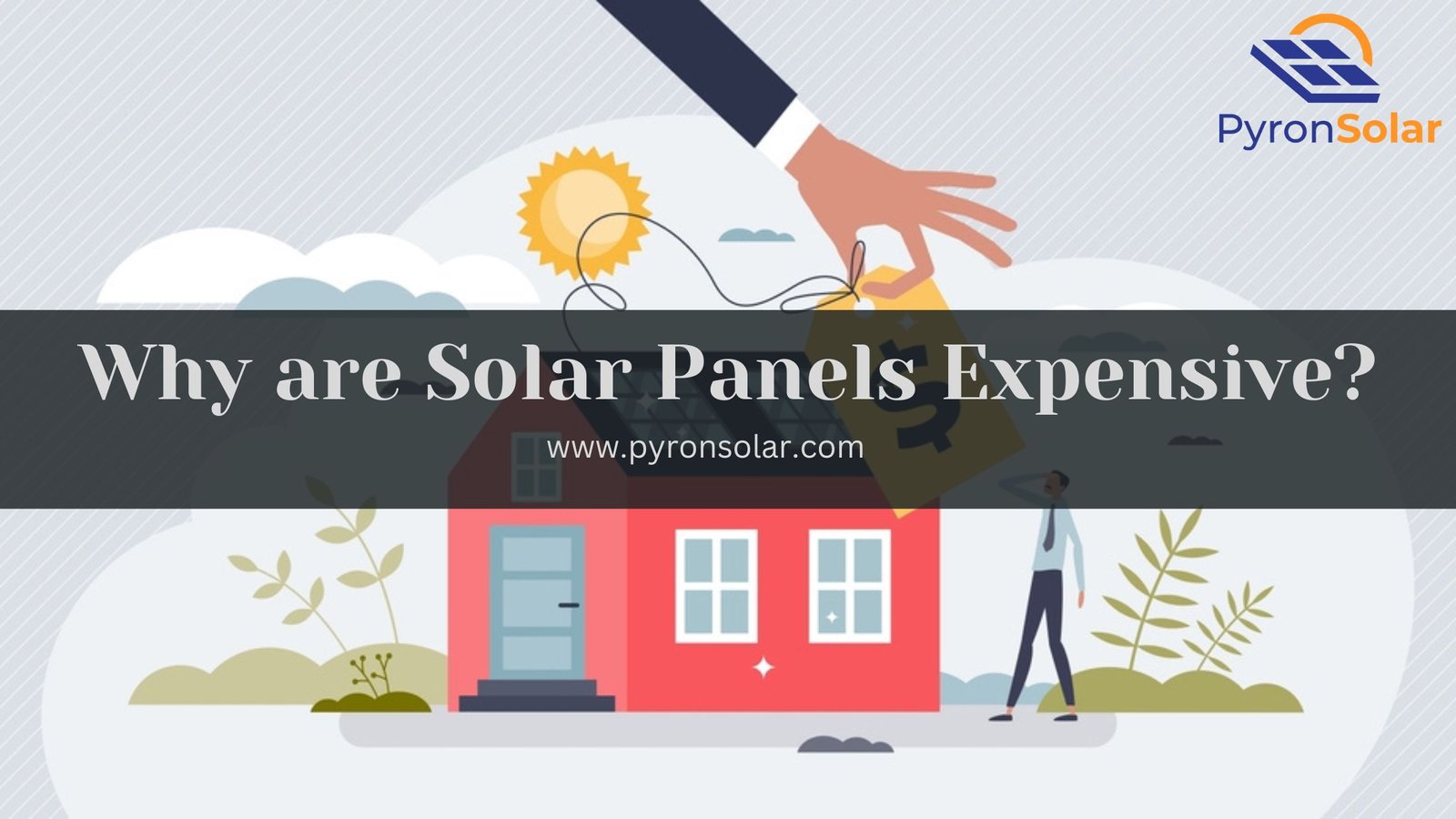Solar energy is the energy trapped from the sun’s radiation that can be harnessed and used for a variety of purposes. Whereas, solar panels are devices made up of multiple PV cells used to absorb the sun’s radiation and convert the energy into heat through the thermal process or electricity through the photovoltaic process.
There are abundant benefits of solar energy and solar panels which improve air quality by reducing greenhouse gas emissions, thereby reducing water consumption as well as land usage and increasing energy independence along with various job opportunities.
Though the benefits might be compelling, its higher upfront costs remain a barrier for many homeowners, discouraging them from opting for long-term savings plans. However, solar panels are worth it as you can maximize savings through tax credits and incentives.
The prime reasons why solar panels have high costs are because of the price fluctuation and increasing demand for raw materials in the market. The manufacturing and installation costs with the varying financing options and inclusion of additional components like batteries and monitoring systems.
By decoding this article, you will gain a deep understanding of how much a solar panel costs, which includes the hard costs of inverters, Installation, equipment, and Supply Chain.
Meanwhile, you should also consider the soft costs of solar panels, which include Installation, Labour, Permit, Inspection & Utility interconnection fees, sales, and marketing.
Also, you will get a perfect guide on installing solar panels during off-peak seasons and how to reduce overhead expenses by increasing the profit margin and looking for the best deal that saves money on your solar panel purchase.
How much does a solar panel system cost?
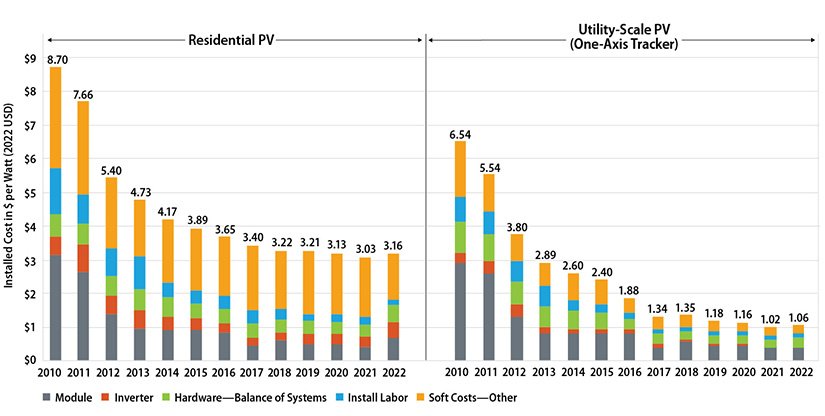
The average 6 kW solar panel system costs around $18,000 to $25,000, which varies based on your location, system size, solar panel type, and many more…
Several factors affect the cost of solar panel systems such as the price of polysilicon, custom duties, inflation levels, metal, and energy prices. Furthermore, the costs are divided into two main categories, namely the hard costs and soft costs.
Hard costs include solar panels, inverters, mounting systems, wiring, and electrical components. Contrarily, the soft costs consist of permits and inspections, installation and labour charges, financing, engineering and design, and many other factors.
What are the hard costs of solar panels?
Hard costs involve all the hardware components of solar panels needed for their functionality, which entails Solar Panels, Inverter, Installation Equipment, and cost of Supply Chain.
Typically, hard costs account for 30 to 40% of the total cost of a home solar system, whereas the remaining portion comes under soft costs.
Solar Panels
Typically, solar panels range between 20 to 40% of the total system price. Various factors affect the price of solar panels, such as:
1. Efficiency and Technology: Monocrystalline panels are more expensive than Polycrystalline panels due to their higher efficiency and advanced technology. Knowing which panel is better, monocrystalline or polycrystalline, will help you to decide to pick the right one.
2. Brand and manufacturers: Different brands have varying price strategies that vary based on their reputation, technology, and warranty offered.
3. Government incentives: Various Subsidies, tax credits, and other incentives affect the overall cost of solar panels.
4. Size and wattage: Large-size panels that generate more electricity have higher wattage, but they are costlier in price.
5. Discounts: Top manufacturers producing solar panels in bulk quantities can offer special discounts for more sales.
Different types of materials are used in solar panels, such as silicon wafers (made from crystalline silicon), tempered glass, metal frames, electrical components (connectors, wires, and junction box), and encapsulation materials (ethylene-vinyl acetate).
The costliest parts of solar panels include silicon wafers, encapsulation materials, High-efficiency panels (monocrystalline), PERC cells, and high-quality back sheet materials.
Generally, the average cost of solar panels varies according to different types, such as:
Monocrystalline: $1 to $1.50 per watt.
Polycrystalline: $0.90 to $1.50 per watt.
Thin-film: $0.50 and $1 per watt.
Inverter
Inverters contribute around 6 to 10% of the total system cost at an average of at an average of $0.18 per watt, with a maximum installation cost of $2.93 per watt.
The price range for a 6kW solar system varies between $1,000 to $3,000, depending on several factors like system size, inverter type, brand and features, power capacity and efficiency. There are a lot more important things to know about solar inverters.
A battery storage system provides a continuous supply of energy during night or power outages. Also, it reduces your dependence on utility and saves money on electricity bills.
The commonly used solar battery systems cost around $400 and $750 per kilowatt-hour (kWh) such as Lithium-ion batteries.
Installation Equipment
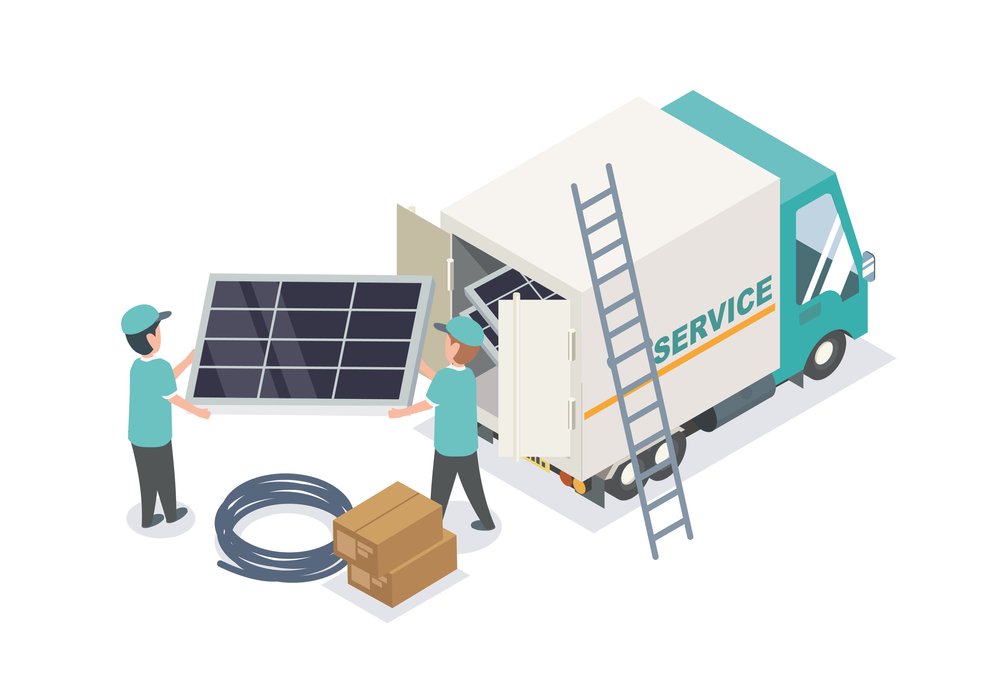
- Solar Panels: Helps to convert sunlight into electricity, which accounts for 20 to 30% of overall system cost.
- Inverter: Converts DC power generated by the solar panels into AC electricity for homes or businesses, which is 6 to 10% of the total cost.
- Racking System: It is installed on rooftops or ground mounts to hold the solar panels firmly, and it is 5 to 10% of the entire system cost.
- Wirings: Connects the solar panels, inverters, and other components to the electrical system, which is 3 to 8% of the total cost.
- Monitoring systems: It is used to track the performance and output of the solar energy system, which is an additional cost.
Based on the stats provided by the National Renewable Energy Laboratory (NREL), the solar racking costs $0.16 per watt (W), which contributes 5% of the total system cost. This varies depending on the System size, roof type and complexity, Mount type, and material to offer durability and ease of installation.
What are the soft costs of solar panels?
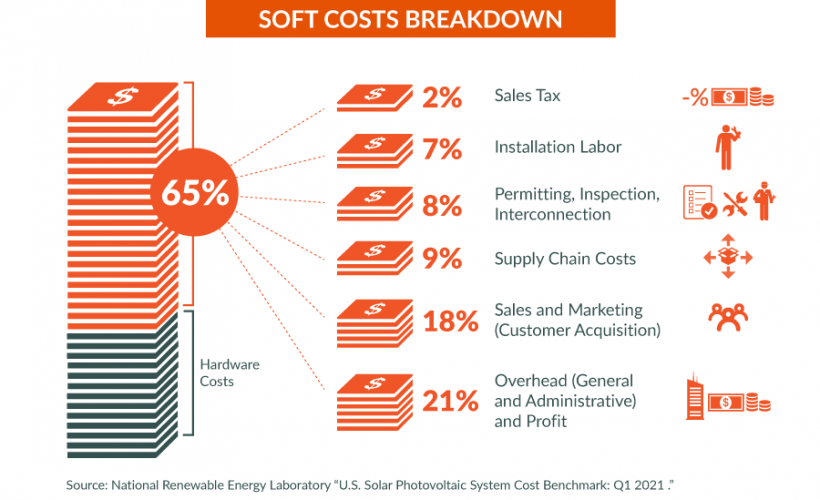
Image Source – Energy.gov
The soft costs of solar panels include the non-hardware components such as permitting, financing, and installing solar. It makes up to 65% of the home solar system.
Breaking down several factors helps you to understand why the soft cost of solar panels is expensive:
- Global market: The solar industry contains numerous companies globally, including installers, financiers, regulatory agencies, and utilities, which results in a complicated and time-consuming process that can push up the cost.
- Rules and Regulations: The navigation permissions, zoning regulations and the interconnection processes require specialized expertise that can add considerable time and expenses to solar panels.
- Financing: The administrative complexities, credit checks, loan processing and transaction fees can increase soft costs.
- Customer Attraction: Attracting new customers and creating awareness about the benefits of solar energy can be expensive for a few companies, which can have an impact on their overall investment.
- Labour specialization: There is a huge demand for skilled labourers in the field of solar panel installation, and training requires an additional investment in the ongoing process.
Installation Labour
The average time for solar panel installation is between 4 and 6 hours or up to 3 days, depending on many factors like system size, weather conditions, roof strength, labour team size and capacity, permits, and inspections.
Typically, solar companies provide labourers for installations, whereas a few others accept the agreement with other companies to hire workers and perform the work. Another alternative includes hiring separate contractors for labour, material, and work permits, which can offer more control and lower costs by finding qualified professionals.
The cost to hire electricians varies between $50 to $150 per hour. It is estimated that the labour cost ranges from 10 to 20% of the total system price.
Permit, Inspection & Utility interconnection fees
The various permits required before installing solar panels include building, electrical, zoning, roofing and houseowner approval.
The average cost of inspection fees varies from $150 to $350 per activity, depending upon the location and complexity of the project. Whereas, the utility and interconnection fees start from $50 and range up to $1,000.
Around 3 to 5% share of the total system costs contribute to the permits, inspection, and utility interconnection fees.
Cost of Supply Chain
The supply chain refers to the network and processes involved in the production and distribution of solar panel components and equipment and materials involved in a solar system installation. Various stages start from raw material sourcing, manufacturing, transportation, logistics, and ultimately to the end users.
Several costs come under the supply chain, such as:
- Raw Materials: Apart from silicon, the extraction, processing, and transportation costs vary for glass, aluminium, and silver.
- Manufacturing costs: The conversion of raw materials into solar panels involves various manufacturing process that yields an additional cost for labour, equipment, facilities, and overhead. You can learn in detail about the manufacturing process of solar panels.
- Transportation and Logistics: Transporting raw materials from factories to distributors and installers can be influenced by factors like shipping distance, fuel costs and demand, and international trade patterns.
- Quality Control and Testing: To ensure that solar panel meets the industry standards and specifications, an additional expense is incurred for quality assurance and testing procedures.
- Packaging and Handling: The packaging materials and handling processes require a separate investment to safeguard the solar panels during transportation and storage before they reach the installers.
Supply chain costs consist of a significant portion of solar panel production, ranging from 20 to 40 %. These costs can vary based on the core components (silicon wafers, inverters, and racking system), market conditions (Fluctuations in raw material prices, transportation costs, and global trade agreements), and locations.
Sales and marketing
The sales and marketing in solar panel installation entails lead generation, attracting potential customers, educating customers about solar energy, building a brand’s reputation, negotiating contracts, and several others. It costs 10 to 20% of the total solar energy system.
Overhead expenses
The hidden costs are commonly known as the overhead expenses, which indirectly support the expense while running a solar installation company to ensure smooth operation and success.
About 5 to 15% of total solar energy system price forms of overhead expenses, which depend on several factors like office expenses, administrative and accounting, vehicle expenses, training, certifications, and many more…
Profit Margin
The profit margin represents the percentage of the remaining revenue after accounting for all expenses associated with any solar project installation. In other words, it conveys the financial stability and long-term sustainability of any installation company.
The average profit for installing solar panels varies within the margin of 20 to 25% of the total cost.
How to Save Money on Your Solar Panel Purchase?
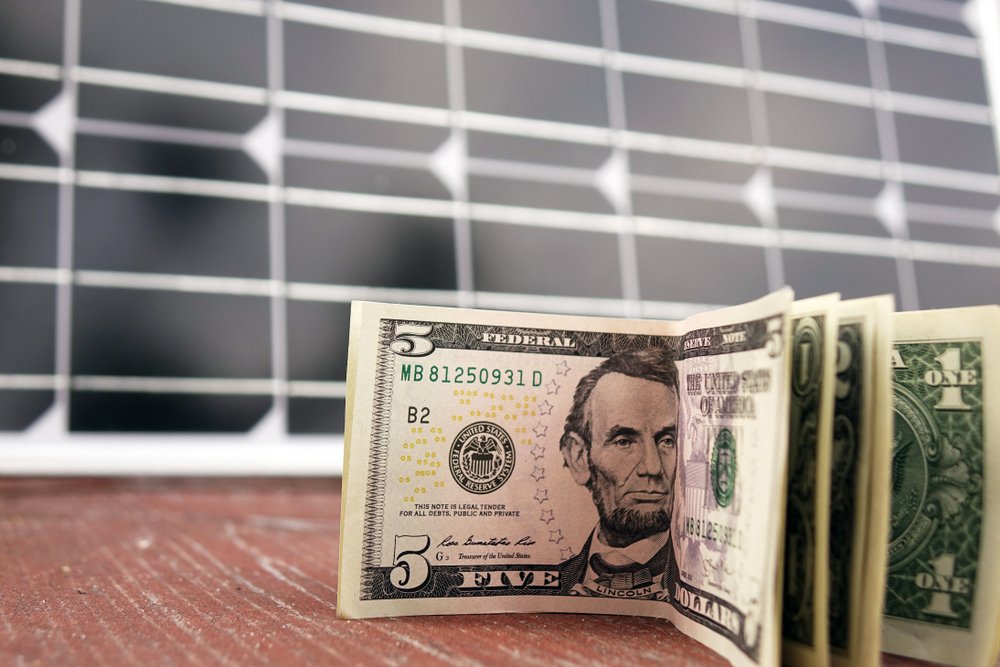
You can easily save money on your solar panel purchase while purchasing solar panels by following these tricks:
- Look for the best deal
- Maximize Savings Through Tax Credits and Incentives.
- Install Solar Panels during off-peak season
- Pick Leasing Over Buying
- Choose an efficient system with a good warranty
- DIY Installation
and many more…
1. Look for the best deal
You should request quotes from multiple companies to compare and negotiate the best deals by looking for the most affordable option. As a result, you can understand the price structure, fees, and warranties offered by different companies by encouraging you to make informed decisions.
Mainly, you will benefit by assessing the quality of services offered by different companies by comparing the quotes. Also, you can use competitive offers when you have more bargaining advantages to push for lower prices and acquire the best quality product.
2. Maximize Savings Through Tax Credits and Incentives
The Federal Government offers solar tax credits whereas the solar and local governments provide incentives to maximize your savings. Also, some utility companies offer incentives such as net metering programs.
The Federal Solar Investment Tax Credit (ITC) covers 30% of solar energy costs, which includes installation as well. Both residential and commercial buildings installing solar panels in 2023 and 2024 will benefit from this scheme, which gradually decreases in the upcoming years. Similarly, to encourage the adoption of solar energy, many local and state governments offer incentives such as cash rebates, tax credits, property tax, and sales tax exemptions.
If you’re a house owner, you can earn Solar Renewable Energy Certificates (SRECs) for electricity generated by solar panels based on your location. Furthermore, you can utilize the database of State Incentives to find out if it is applicable in your area. Mainly, you should consult a tax advisor for detailed guidance about Federal Tax credits.
Several tax credits and incentives can help you reduce upfront costs by offering more affordable and financially attractive options for house owners and businesses. The amount you save depends upon many factors, like the size and cost of your solar panels, applicable taxes, net metering policies, and available state and local incentives.
3. Install Solar Panels during off-peak season
The off-peak period for installing solar panels includes early winter, spring and autumn seasons.
At times, the off-peak seasons are beneficial for buyers to install solar panels due to their lower installation cost, faster installation times, and additional tax benefits. But, you need to compare the quotes from multiple installers by considering the long-term benefits. At the same time, you need to look into the drawbacks, such as weather conditions, reduced sunlight hours, and limited installer availability during the off-peak season.
4. Pick Leasing Over Buying
The leasing concept allows customers to pick up solar panels by overcoming the higher upfront costs of solar equipment and installation.
Several reputed solar companies like Sunrun, Tesla, and Vivint Solar offer leasing options. Additionally, a few third-party financiers as well as enrolling into Community solar programs offer leasing, which is better than installing an entire system.
Rather than paying for the whole system, you can pay a fixed amount monthly for the electricity generated by the solar panels.
5. Choose an efficient system with a good warranty
Choosing an appropriate size and efficient system with a good warranty provides you with numerous benefits, such as cost savings, grid independence, minimizing potential environmental concerns, and enhanced energy production. This motivates you to maximize your investment.
Similarly, by selecting a good warranty package, you can experience long-term performance with reduced repair costs, thereby indicating the manufacturer’s trust in the product’s quality and durability.
6. DIY Installation
The DIY (Do It Yourself) solar panel installation can be a tempting choice, which offers cost savings and a feeling of achievement. You need to implement the entire process yourself, starting from planning and research for purchasing materials, constructing the system, and grid connection. But, you need to require technical skills, knowledge about electrical codes as well as access to specialized equipment.
There are many benefits of the DIY method which helps you to gain knowledge about solar technology and maintenance. As a result, you will have complete control over the system design and choosing a variety of components, which saves your budget and provides immense satisfaction.
Simultaneously, there are many drawbacks of DIY solar panel installation, which include technical complexity, safety risks, warranty limitations, violating regulations, and limited troubleshooting assistance.
Are Solar Panels Worth it despite the high cost?
The upfront costs of solar panels for residential buildings in the US range between $8,500 to $30,500 for an average 6kW solar system, which varies according to size, location, and equipment.
Despite its higher costs, solar panels offer various benefits such as Energy Savings, Financial Incentives, Enhanced Property Value, Reduces Carbon Footprint, Energy Independence and several others.
Additionally, you can have financial gains with the scheme of net metering and off-grid. You can sell excess solar energy back into the grid using the net metering system that allows you to earn credits by reducing your electricity bills. Going off-grid requires additional battery storage, which has a high initial cost but makes you energy-independent on a long-term basis.
The prices of solar panels have been declining for the past decade, which makes them affordable for all levels of users. It is because of technological advancements, increased manufacturing, efficient production methods, and intense competition in solar energy with the increasing demand. According to the Solar Energy Industries Association (SEIA), the cost of solar panels has declined by more than 70% since 2010.
The payback period for solar panels represents the time taken to recover the installation costs for the entire system. It completely depends upon your installer, the total number of solar panel installations, and how much you pay for your system. Also, it is estimated that the average payback period for solar panels ranges between 6 and 10 years.
Ray is an avid reader and writer with over 25 years of experience serving various domestic and multinational private and public energy companies in the USA.

